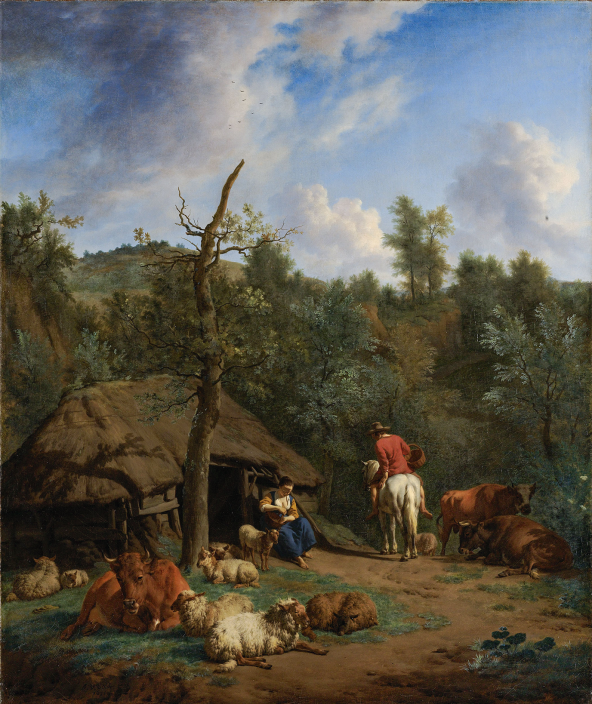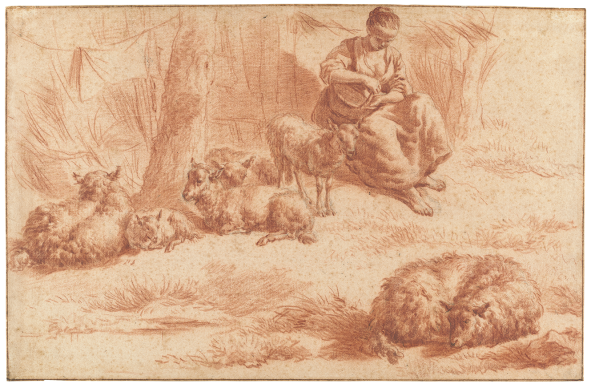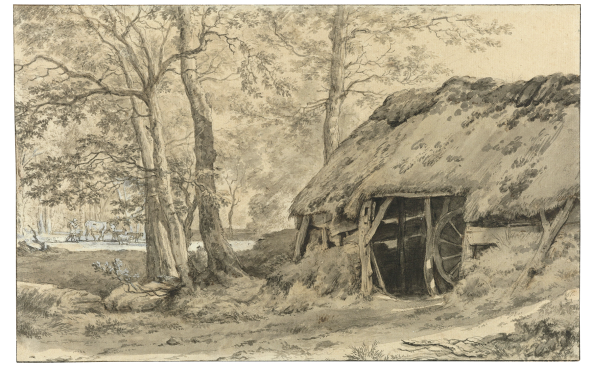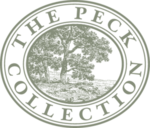Choose a background colour
Adriaen van de Velde, Dutch, 1636-1672: Study of a Hut or Sheepfold, c. 1671
Gray wash over black chalk on paper; framing lines in gray ink.
7 × 10 13⁄16 in. (17.8 × 27.5 cm)
Verso, lower center, in pencil, A. van de Velde, lower left, /r.v:-, and upper right, XZ.
- Chain Lines:
- Horizontal, 22 – 24 mm.
- Watermark:
- Two standing lions in a crowned shield above the letters BW.
- Provenance:
Jacob de Vos Sr., 1735 – 1833, Amsterdam; his sale, De Vries, Roos et al., Amsterdam, 30 – 31 October 1833, Album W (fl . 100 to De Vries), no. 5; Jacob de Vos Jr., 1803 – 1878, Amsterdam (Lugt 1450, stamp on verso); his sale, Roos, Muller & Co., Amsterdam, 22 – 24 May 1883, lot 550; Constant C. Huijsmans, 1810 – 1886, Breda, and Antonie Jacobus van Wijngaerdt, 1808 – 1887, Haarlem; their sale, Muller, Amsterdam, 21 – 22 June 1887, lot 222; August Sträter, 1810 – 1897, Aachen (Lugt 787, stamp on verso); his sale, H. G. Gutekunst, Stuttgart, 10 – 14 May 1898, lot 1207; Rudolph P. Goldschmidt, c. 1840 – 1914, Berlin (Lugt 2926, stamp on verso); his sale, F. A. C. Prestel, Frankfurt, 4 – 5 October 1917, lot 593; H. C. Valkema Blouw, 1883 – 1953, Zeist (Lugt 2505); his sale, F. Muller, Amsterdam, 2 – 4 March 1954, within lots 725 – 34; Hans van Leeuwen, 1911 – 2010, Amerongen (Lugt 2799a, stamp on verso); his sale, Christie’s, Amsterdam, 24 November 1992, lot 204; Sheldon and Leena Peck, Boston (Lugt 3847); gift to the Ackland Art Museum, inv. no. 2017.1.85.
- Literature/Exhibitions:
Utrecht 1959 – 60, no. 69; Laren 1963, no. 113; Nijmegen 1965, no. 39; Leeuwarden 1966, no. 31; Bonn, Saarbrücken & Bochum 1968 – 69, no. 138; Rheydt 1971, no. 77; Schatborn 1975; Amsterdam 1975 – 76, no. 124; Robinson 1979, 18, no. A – 3; Bremen, Braunschweig & Stuttgart 1979 – 80, no. 139; P. Schatborn in Amsterdam & Washington 1981 – 82, 117, no. 6; Schapelhouman & Schatborn 1987, under no. 69; F. Robinson in Chapel Hill, Ithaca & Worcester 1999 – 2001, 102 – 03, no. 34; Vancouver 2009, 136; Paris 2009 – 10, 158 – 59, under no. 61; Amsterdam & London 2016 – 17, 141 – 47, no. 31.
- Ackland Catalogue:
- 2017.1.85
Adriaen van de Velde maintained a weekly drawing practice in the countryside throughout his lifetime as an artist. Despite this, only a few of his landscape drawings created outdoors survive, making this an important sheet. It depicts a ramshackle hut, or sheepfold, built for sheltering sheep or other livestock. Van de Velde conveys the beauty of this commonplace subject through his expert application of black chalk and wash to suggest the effects of natural sunlight on the rustic surroundings. The artist subsequently used this, and other drawings, for a famous painting now in the Rijksmuseum, Amsterdam, providing us important insight into his working methods.
Adriaen van de Velde was one of the most committed and brilliant draftsmen of his day, possessing a remarkable facility with just about every type of drawing media in use at the time.1
This sheet displays Van de Velde’s ability to vividly convey natural sunlight effects by simply using black chalk and wash, seen and even felt here in the gleaming radiance of the hut on an obviously bright day. The long, bent shadow cast by the foreground tree on the rooftop is a virtuosic touch that gives a strong sense of the height and angle of the sun. This hut, or sheepfold (schaapskooi), likely appealed to Van de Velde for its ramshackle and authentically rustic character, a structure not intended for human habitation but for storage or for sheltering sheep or other livestock. The image gives every appearance of having been drawn from life. We learn from Arnold Houbraken (1660 – 1719) that Van de Velde made a weekly lifelong practice of taking his equipment into the countryside to make drawings, an anecdote reported to the biographer by the artist’s daughter.2
One can imagine that a drawing like this resulted from one of those sojourns. Despite his prolific drawn output, a drawing of this type nevertheless remains extremely rare in his oeuvre.3
Though a large number of Van de Velde’s animal and figures studies from life are known among his over 200 surviving drawings, only a precious few of his landscape studies that appear to have been drawn outdoors have come down to us.4
This drawing holds a special place in Van de Velde’s corpus for its rarity as a landscape study and for its use for one of the artist’s most famous paintings, The Hut, dated 1671 Fig. 56.1.5

Adriaen van de Velde, The Hut, 1671. Oil on canvas, 76 × 65 cm. Amsterdam, Rijksmuseum, inv. no. SK-A-443.
Rijksmuseum, Amsterdam
The Rijksmuseum acquired the painting in 1822, quite early in its institutional history, paying the then-enormous sum of 8,290 guilders, making it one of the most expensive paintings of the day.6
The director of the museum at the time, Cornelis Apostool, called it “one of the greatest of all fruits brought forth by the Dutch School,” noting in particular its realism and outstanding sense of draftsmanship.7
No fewer than five drawings survive that served in some capacity as studies for the painting, and they prove useful for understanding Van de Velde’s process.8
He drew a life study in red chalk of the woman holding a basket, from which he took a counterproof (probably by wetting a piece of paper and rubbing it on the original, or by running it through a printing press) that reversed her direction, to give the orientation seen in the painting. Both the original and counterproof survive.9
He also drew two red chalk studies of the animals in the foreground, one of which includes the woman among them Fig. 56.2.10

Adriaen van de Velde, Shepherdess with Sheep, 1671. Red chalk over a sketch in graphite or black chalk, 193 × 298 mm. Amsterdam, Amsterdam Museum, C. J. Fodor Bequest, inv. no. TA 10345.
Amsterdam Museum, bequest of C. J. Fodor
When he used the present drawing to add the hut to the painting, Van de Velde removed the dog and added a few touches of foliage to the tree. He changed little else except to make the timbers around the door stand just slightly more upright, perhaps to lend a greater air of stability to the structure in the painting. Given how closely these drawings relate to the painting, it seems reasonable to date them around the same time as the canvas. Van de Velde was known to recycle some of the motifs from his studies from time to time (as did other artists), and it is possible that some of these sheets date somewhat earlier, though no other painting with a similar hut has come to light.11
The setting for the painting appears to be in the high dunes along the North Sea coast, perhaps outside of Haarlem or The Hague, where such short bristly trees are found. The hut in the Peck drawing, however, could have been found throughout the land. Another drawing in the Rijksprentenkabinet of a hut or sheepfold by Van de Velde depicts a similar structure from a different angle Fig. 56.3.12

Adriaen van de Velde, A Hut in the Woods, c. 1646 – 72. Black chalk, brush and gray and black ink, heightened in places with white body color, 184 × 291 mm. Amsterdam, Rijksmuseum, Rijksprentenkabinet, inv. no. RP-T-1902-A-4603.
Rijksmuseum, Amsterdam
This drawing seems more like a finished work composed in the studio than a study from life.13
Van de Velde’s choice to convey the beauty of a dilapidated structure in these works marks the tail end of an appreciation of the “picturesque” (schilderachtig) in contemporary art theory.14
Such an emphasis on the commonplace featured heavily in the seventeenth-century Dutch landscape tradition, but soon disappeared in favor of more idealized and sylvan evocations of nature and its rustic inhabitants.
End Notes
While there is no overarching study or catalogue of his corpus of drawings of over 200 sheets, for the two major studies of his drawings, see Robinson 1979 (for the preparatory drawings, cataloguing fifty-six works); and Eerenbeemd 2006 (for the Italianizing landscapes, cataloguing sixty-five works). For an introduction to Van de Velde’s life and art generally, see B. Cornelis in Amsterdam & London 2016 – 17, 11 – 39; and for a concise consideration of his preparatory drawings, see W. W. Robinson in Washington & Paris 2016 – 17, 254 – 59, nos. 115 – 17.
Houbraken 1718 – 21, vol. 3, 90 – 91.
Robinson 1979, 4 – 5, 18 (nos. A1 – A3).
In terms of preparatory studies, Robinson catalogued only two other plein air landscape drawings aside from the present sheet. The first is in the Fodor Collection, Amsterdam Museum (inv. no. A10348), for which see Robinson 1979, 18, no. A1; Broos & Schapelhouman 1993, 180, no. 137; and W. W. Robinson in Washington & Paris 2016 – 17, 256, no. 116. The second is in the Kupferstichkabinett, Berlin (inv. no. 3858), for which see Robinson 1979, 18, no. A2; and Bock & Rosenberg 1930, vol. 1, 293, no. 3858.
For the painting, see M. Schapelhouman in Amsterdam & London 2016 – 17, 141 – 47, no. 30, with further references.
Schatborn 1975, 159.
Schapelhouman in Amsterdam & London 2016 – 17, 141.
For the essential study of these drawings, including the present sheet, and how they relate to the painting, see Schatborn 1975. See also Amsterdam & Washington 1981 – 82, 116 – 17; and Robinson 1979, nos. A-3, D-17, D-18, D-24.
Schatborn 1975, 161 – 62, figs. 2 – 3; Robinson 1979, 22, no. D-17; and Amsterdam & London 2016 – 17, 147, no. 34, fi g. 150.
Schatborn 1975, 162, fi g. 4; Robinson 1979, 22, no. D – 18; Broos & Schapelhouman 1993, 187 – 88, no. 143; and Amsterdam & London 2016 – 17, 144, no. 32.
For the recycling of his study drawings, see, for example, Robinson 1979, 23, no. D-24.
Amsterdam, Rijksmuseum, inv. no. rpt-1902-a-4603. For this drawing, see Schapelhouman & Schatborn 1987, no. 69; M. Schapelhouman in Vancouver 2009, 136 – 37; and idem in Amsterdam & London 2016 – 17, 173 – 75, no. 45.
But see F. Robinson in Chapel Hill, Ithaca & Worcester, 1999 – 2001, 102 – 03, no. 34, who suggests, by contrast, that the Rijksmuseum drawing (in note above) was made from life and used to prepare the present sheet.
For this type of rustic structure in Dutch art and its place in contemporary art theory, see Gibson 2000, 141 – 72.
